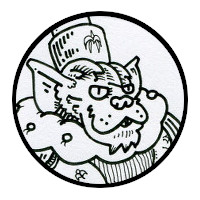
“Arjonne Vegtzwyn, a famous Ruyterre.”
RUYTERRE ARJONNE VEGTZWYN,
dien geweldige Kryggstre
met eur Kleerhaeck*
THE PARAGON OF MARTIAL TRADITION and scholarly wisdom is found in those who combine tradition and method, knowledge & skill.
The Ruyter† is both a master of mêlée and a philosopher of war.
Sometimes a professional soldier who foregoes mythology over reality and embraces violence when needed. Sometimes they are philanthropists that heal and protect society in ways that only these stoic warriors could achieve.
RUYTERS ARE ANOINTED by their forebears, either after a period of apprenticeship or through excellence in battlefield tactics. There are recorded cases of skillful neophytes being sired by their victorious opponents after the dust has settled on the battlefield. Occasionally physical prowess is of secondary importance when considering someone for admission, as martial skill will develop through training and a clumsy warrior may still posses a keen mind.
The title itself is non-inheritable but essentially brings with it the chance to climb the social ladder, granting entrance to exclusive libraries, schools & training. The path is different for every individual and there is little in the way of official tradition.
Some members of the profession will remain on the front lines as fearsome sergeants, others may go on to become military advisers, military engineers or even civil architects.
THESE PALADINS HOWEVER are indentured to any particular ruler or city, but enjoy great freedom to whom and where they offer their services.
Those members of the Ruyters ‘caste’ that are bestowed with a hereditary right to the title are knowns as Grootruyters‡. There are but few Grootruyter-clans but most of them have rich holdings and -through their independence- hold positions of great power in the political landscape. Their military support is highly coveted by some bickering rulers of city-states. Often a Grootruyter has only to declare his preference for 1 side or the other to tip the balance in a conflict. In these cases a diplomatic solution will be agreed upon, and no side has even to bring troops afield. This is for the best, as truly skilled Ruyters are rare compared to the massed mobs of militiamen and mercenaries. Prolonged conflicts would soon drain the Ruyter-caste of its most proficient indivduals. During wartime they remain, after all, important tactical assets as well as high-profile strategic targets.
DEPICTED ABOVE is the renowned Arjonne Vegtzwyn°, famed for her excellence in wielding the KleerhaeckΔ.
She attained her fame & title at a pitched battle between opposing armies. She wrestled her way through the opposition, reached the enemy general, and -using her billhook- lifted him up by his underpants, stretched them up and over his head until they were torn apart. The general, having lost face in front of the entire opposing army, soon lost control over his army, and swiftly fled the field of battle.
Arjonne would later go on to become the spouse of Juppe Desnonck, the Prince of Sweets, so named for his iron grip on the fruit trade.
Notes
The image caption translates to:
“Ruyterre Arjonne Vegtzwyn, that great warrior with her Kleerhaeck.“
Ruyter (m) / Ruyterre (f) — Rider; a noble title, sometimes used as catch-all term for armored combatants, wether mounted or not.
From Dutch: ‘ridder’, and ‘ruiter’ (knight, rider)
Grootruyter — Great-Rider; military campaigns that feature Grootruyters on both sides will either remain bloodless or likely result in a total mutual wipe-out: the tactical maneuvering between generals being akin to chess. This predictable outcome is of course a prime deterrent to total war.
Vegtzwyn — “Fight-Boar”
From Dutch: ‘vecht(en)’ (fighting, to fight) and ‘zwijn’ (boar)
Kleerhaeck — This short type of polearm was at one point considered a most un-heroic weapon since along with its lethality it brings about great damage and tearing to the opponents clothing and flags. Needless to say this is an affront to the crucial tradition of dressing up fancy for battle and swirling about all dandy & colorful.
For this reason the weapon has been banned from use in most tournaments & parades.
From Dutch: ‘kledinghanger’, ‘klederhaak’ (clothes hanger / -hook)
See also: Non-lethal Weaponry aka Kloppeghyttes






